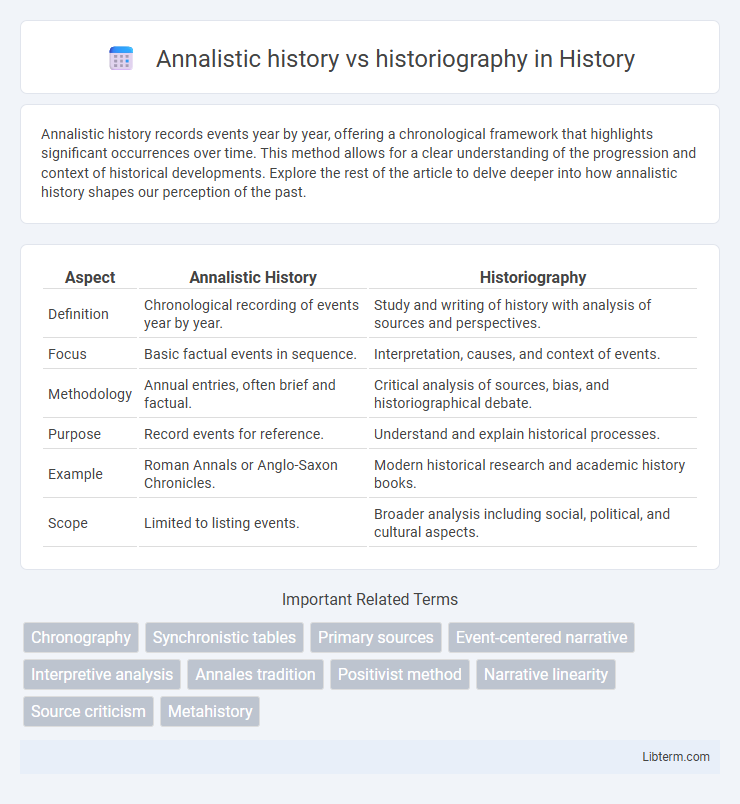Annalistic history records events year by year, offering a chronological framework that highlights significant occurrences over time. This method allows for a clear understanding of the progression and context of historical developments. Explore the rest of the article to delve deeper into how annalistic history shapes our perception of the past.
Table of Comparison
| Aspect | Annalistic History | Historiography |
|---|---|---|
| Definition | Chronological recording of events year by year. | Study and writing of history with analysis of sources and perspectives. |
| Focus | Basic factual events in sequence. | Interpretation, causes, and context of events. |
| Methodology | Annual entries, often brief and factual. | Critical analysis of sources, bias, and historiographical debate. |
| Purpose | Record events for reference. | Understand and explain historical processes. |
| Example | Roman Annals or Anglo-Saxon Chronicles. | Modern historical research and academic history books. |
| Scope | Limited to listing events. | Broader analysis including social, political, and cultural aspects. |
Understanding Annalistic History
Annalistic history is a chronological record of events arranged year by year, emphasizing a factual and linear account without extensive analysis or interpretation. Understanding annalistic history involves recognizing its role in providing a foundational timeline that historians use as raw data for further study. This approach contrasts with historiography, which critically examines how history is written and interpreted, focusing on methodology, bias, and narrative construction.
Defining Historiography
Historiography refers to the study of historical writing and the methods historians use to interpret and present past events. Unlike annalistic history, which records events in chronological order without analysis, historiography emphasizes the critical examination of sources, narrative techniques, and the historian's perspective. Understanding historiography involves recognizing how historical interpretations evolve over time based on cultural, ideological, and methodological shifts.
Origins and Development of Annalistic Tradition
The annalistic history tradition traces its origins to ancient civilizations such as Mesopotamia and Rome, where events were recorded year by year in chronological lists, emphasizing a straightforward and factual approach. This method developed through public inscriptions and state-sponsored records that prioritized political and military occurrences over interpretative analysis. Unlike historiography, which evolved to include critical examination and narrative construction, the annalistic tradition maintained a focus on preserving a sequential log of events as a foundational source for future historical inquiry.
Evolution of Historiographical Methods
Annalistic history centers on chronological year-by-year records, emphasizing factual recounting of events with limited interpretation. Historiography evolves by incorporating critical analysis, source evaluation, and thematic perspectives, transforming history into a reflective discipline influenced by cultural and ideological contexts. This progression from annalistic documentation to complex historiographical methodology highlights the shift towards understanding historical processes and narratives rather than mere event listing.
Key Differences: Annals vs. Historiographical Narratives
Annals present historical events in a chronological, year-by-year format, emphasizing precise dating and factual recording without interpretation. Historiographical narratives, on the other hand, offer thematic, analytical storytelling that explores causes, contexts, and consequences, providing a broader understanding of history. The key difference lies in annals' factual compilation compared to historiography's interpretive and critical approach to historical events.
Sources and Evidence in Annalistic Writing
Annalistic history relies heavily on chronological records drawn from primary sources such as official documents, inscriptions, and eyewitness accounts to ensure factual accuracy and temporal sequencing. These sources often include annals, chronicles, and administrative records that provide a straightforward, year-by-year account of events without extensive interpretation. The evidence in annalistic writing emphasizes the preservation of events as they occurred, prioritizing the authenticity and reliability of documented occurrences over analytical narrative.
Interpretation and Analysis in Historiography
Historiography emphasizes interpretation and analysis by critically examining sources, context, and bias to construct nuanced narratives of past events. Unlike Annalistic history, which records events chronologically with minimal analysis, historiography involves evaluating diverse perspectives and theoretical frameworks to understand underlying causes and implications. This approach deepens historical insight through reflective storytelling and intellectual inquiry rather than mere chronological listing.
Influence of Annalistic History on Historical Recording
Annalistic history, characterized by chronological year-by-year entries, laid foundational methods for systematic historical recording and influenced the structure of later historiography. This approach enabled the preservation of events in a sequential framework, fostering the development of more analytical and interpretive historical narratives in subsequent historiographical traditions. Its impact is evident in the way historical records emphasize accuracy, continuity, and empirical data to construct coherent historical accounts.
Critiques and Limitations of Annalistic Approaches
Annalistic history, characterized by year-by-year chronological records, often faces critiques for its lack of analytical depth and context, limiting its ability to interpret historical causality or significance. Historiography emphasizes the importance of critical analysis, interpretation, and the theoretical framework, addressing the annalistic approach's constraints by situating events within broader socio-political and cultural dimensions. The limitation of annalistic methods lies in their tendency to present isolated facts without exploring the complexities that historiographical methods reveal through thematic and comparative analysis.
Modern Relevance: Bridging Annalistic History and Historiography
Modern relevance of annalistic history lies in its potential to complement historiography by providing chronological frameworks that enhance narrative depth and analytical rigor. Integrating annalistic records with historiographical interpretation fosters a comprehensive understanding of historical events, emphasizing temporal precision alongside thematic exploration. Bridging these methodologies supports interdisciplinary research and enriches contemporary historical scholarship by balancing factual chronology with critical analysis.
Annalistic history Infographic

 libterm.com
libterm.com